
- SAP Community
- Products and Technology
- Additional Blogs by Members
- Cibernators @ SAP InnoJam Sydney 2011 – Disaster A...
- Subscribe to RSS Feed
- Mark as New
- Mark as Read
- Bookmark
- Subscribe
- Printer Friendly Page
- Report Inappropriate Content
Intro:
On Saturday July the 30th at 1pm the first InnoJam in Sydney was kicked off at the UTS Business school in Sydney. Nothing prepared, the only thing we knew was that we had 30 hours to create a solution for a business case, and present it within 6 minutes to a jury…
More information around the event can be found here: http://wiki.sdn.sap.com/wiki/display/events/SAP+InnoJam+Sydney+2011
This blog is to outline the details of our solution. First the business case (BizFire) and after that we’ll dive into the dirty details of the solution (Tech Fire). At the end some final words and experiences.
Biz Fire:
The idea originated from one of our colleagues (Tom Hallett) who was rudely awoken by an earth quake while on a project in Christchurch, New Zealand. Not an experience he’ll quickly forget but it fuelled an excellent business case for our InnoJam solution. The idea was born to build a Disaster Alert & Response Management System. A system which will provide a trigger for a (retail) company in case of a disaster and respond to it quickly and effectively.
The high level process that it needs to support is the following.
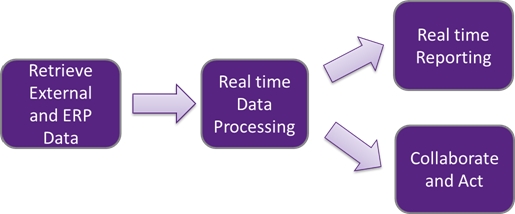
In short the solution provides continuous real time retrieval of external data and processing of this data. As soon as a new quake occurs the solution needs to notify the stakeholders to take action. This is done by creating a ‘virtual’ collaboration room where the stakeholders can create and follow up actions. Secondly the solution needs to provide the managers sufficient information through reporting to be able to act and understand what the effect is of the quake on the business. More specifically the following data needs to be provided:
- Show locations (stores, DC's, offices) affected by the natural disaster
- Alert regional management to contact staff in stores, DC's & offices to ensure everybody is safe and accounted for
- Show stock in affected locations and provide assessment on potential stock loss (derived from the impact of the natural disaster) as well as impact on future total forecasted sales
- Show outstanding sales orders to customers from affected locations and trigger follow-on actions such as changing the fulfilment to another location unaffected by the natural disaster
- Show vendors and PO's that have been placed for affected locations – put plan into action to either cancel PO's or deliver them to another location
- Create a Collaboration room within SAP StreamWork and automatically invite respective members of the management team
With that in mind we started looking at a solution to support it.
Tech Fire:
We started by looking at what type of architecture we would need on the basis of the available new technology SAP provided to us during the InnoJam.
Below a screenshot of the SAP StreamWork / Gravity solution diagram we drew up during the InnoJam.

The solution combined several data sources together which were processed by BusinessObjects Data Services and then fed into HANA. HANA provided the real time reporting capabilities to a BI Mobile iPad app and a BusinessObjects Dashboard. Parallel to this an alert, in case of a new quake, needed to be created in HANA so that an emergency Streamwork collaboration room would be created.
The solution when originally drawn up included (of course) more components but with limited amount of time you quickly revert back to the basics. In the next paragraphs the different components will be described in more detail.
Data sources
- External Source - Geonet.org.nz
The quake data is provided by geonet.org.nz which provides a service to retrieve near real time quake information. We were quite amazed to learn that for New Zealand there were 5000+ quakes recorded for 2010 with a magnitude larger than 3. See http://geonet.org.nz/for more information.
- External Source - Twitter
The twitter information was to further understand the intensity and effect of the earthquake on the basis of the tweets. This was to understand the public sentiment around the earthquake as a factor in the impact analysis.
- ERP (SAP ECC)
This provided us the Employee/Store/Vendor/Purchase and Sales order information.
Data processing
- BusinessObjects Data Services
Data Services is the best practice solution for importing data into HANA. It also provides functionality to do Text Analysis for the Twitter information and cleanse the data where necessary. Unfortunately BusinessObjects Data Services was not available in the provided SAP Landscape so we resorted to some custom development to get the data into HANA, which in itself was an interesting exercise and left the sentiment analysis for what it was.
- HANA
The In-Memory capability of HANA provides real-time analysis of high-volumes of data. It calculates which stores were impacted the most on the basis of the distance from the quake centre and the depth of the quake. HANA will also trigger an alert when a new disaster has occurred.
Our tables in HANA:

Creating the views for reporting:

Reporting/Collaboration
- BI Mobile iPad app
The mobile app provides a solution for managers which are on the move to have all the data readily available at their fingertips.

Using a map with visual appealing icons (red for high, orange for medium and grey for low impact) the store locations and the location of the quake centre is provided. The quake center depicted in the screenshots is the actual quake that occurred in September 2010.
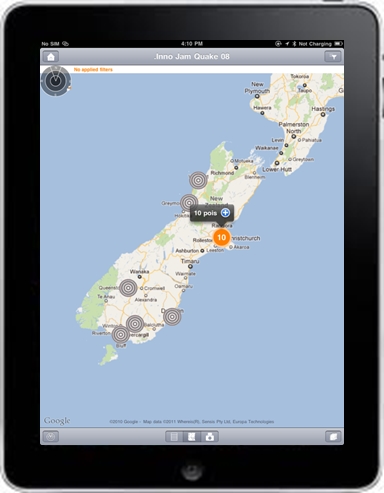

The mobile app provides the functionality to do further analysis on the affected stock and the number of employees that are affected.
- BusinessObjects Dashboard 4.0
The dashboard provides consolidated disaster management & recovery information
The affected stock levels:
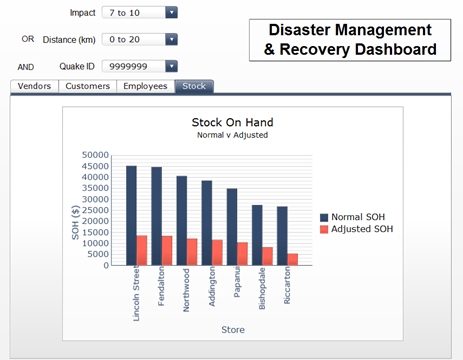
The affected employees per store:
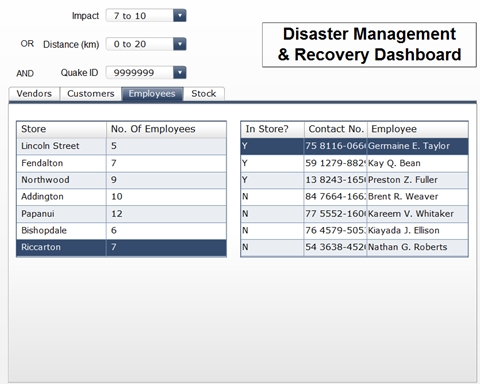
The affected customers that need to be contacted since their delivery will be delayed:

The affected vendors which need to be contacted since the delivery needs to be cancelled or deferred to another location:

- SAP StreamWork
SAP StreamWork is a collaboration platform. One of the tools we used ourselves is the Gravity BPM tool which allows you to model business processes collaboratively. Hence the unorthodox system landscape screenshot from the Gravity tool at the beginning of this blog. SAP StreamWork is an excellent platform to share information in a distributed team setting, but also to provide a centralized collaboration room for managers when a disaster hits their company. HANA triggered the creation of a collaboration room in SAP StreamWork and the respective managers were notified of this via email through SAP StreamWork automatically.
The automatically created activity:
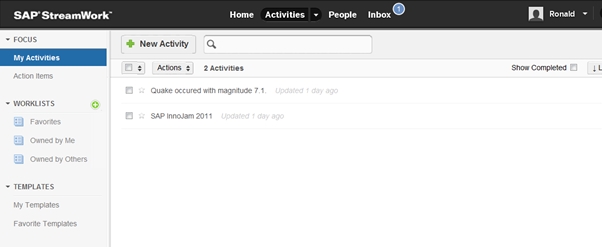
The collaboration room is ready to use with the stakeholders invited:
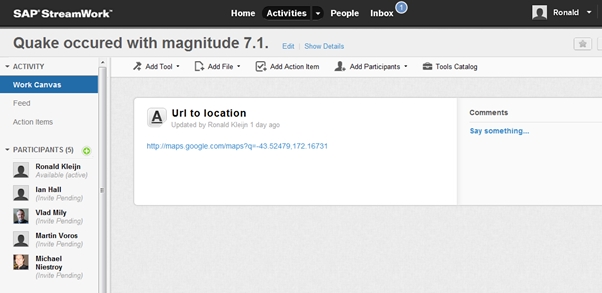
Final Words:
It was a great event and it provided great insight in some of the new technology provided by SAP. Even though we didn’t incorporate all technologies in our solution the event provides the ability to talk to the SAP experts in a relaxed setting which gives you ample time (30 hours) to get better insight in also the technologies you are not using.
Unfortunately the systems provided weren’t fully integrated and some key pieces of software were missing to make it a fully integrated solution, but this did not affect the learning curve and the result in any way shape or form.
Last but not least I would like to thank my team for their hard work and dedication:
- Ian Hall
- Tom Hallett
- Vlad Mily
- Michael Niestroy
- Martin Voros
- Incentive Management OData APIs (Kubernetes) Questions in Technology Q&A
- API Management: Unlocking OAuth Strategies in Technology Blogs by SAP
- The 2024 Developer Insights Survey: The Report in Technology Blogs by SAP
- Hybrid Architectures: A Modern Approach for SAP Data Integration in Technology Blogs by SAP
- Vectorize your data for Infuse AI in to Business using Hana Vector and Generative AI in Technology Blogs by Members